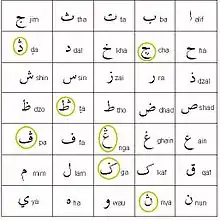Pegon script
Pegon (Javanese: أَبْجَدْ ڤَيڬَونْ, romanized: abjad Pégon)[1] is an Arabic script used to write the Javanese, Madurese and Sundanese languages, as an alternative to the Latin script or the Javanese script[2] and the old Sundanese script.[3] In particular, it was used for religious (Islamic) writing and poetry from the fifteenth century, particularly in writing commentaries of the Qur'an. Pegon includes symbols for sounds that are not present in Modern Standard Arabic. Pegon has been studied far less than its Jawi counterpart for Malay, Acehnese and Minangkabau.[4]
| Pegon script أَبْجَدْ ڤَيڬَونْ | |
|---|---|
| Type | |
| Languages | |
Time period | c. 1300 CE to the present |
Parent systems | |


Etymology
The word Pegon originated from a Javanese word pégo, which means "deviate", due to the practice of writing the Javanese language with Arabic script, which was considered unconventional by Javanese people.[1]
History
One of the earliest dated examples of the usage of Pegon may be Masa'il al-ta'lim, a work on Islamic law written in Arabic with interlinear translation and marginal commentary in Javanese. The manuscript is dated 1623 and written on dluwang, a paper made from the bark of the mulberry tree.[5]
Comparison of Jawi and Pegon
The main difference between Jawi and Pegon is that the latter is almost always written with vocal signs. Since the Javanese language contains more aksara swara (vowel signs) than their Malay counterpart, vocal signs must be written to avoid confusion. Aside from Malay, Javanese language also use a similar writing system without vocal signs called Gundhul.
Transliteration
The United States Library of Congress published a romanization standard of Jawi and Pegon in 2012.[6]
See also
- Jawi alphabet
- Abjad Pegon (in Indonesian)
- Abjad Jawi (in Indonesian)
Footnotes
- Poerwadarminta 1939, pp. 481.
- Javanese script (Akṣara Carakan) on Omniglot. Retrieved 14 March 2019.
- Sundanese script (Akṣara Sunda) on Omniglot. Retrieved 14 March 2019.
- van der Meij, D. (2017). Indonesian Manuscripts from the Islands of Java, Madura, Bali and Lombok (p. 6). Leiden, Netherlands: Brill.
- "Southeast Asian manuscripts digitised through the Ginsburg Legacy - Asian and African studies blog". britishlibrary.typepad.co.uk. Retrieved 29 March 2019.
- The Library of Congress. (2012). ALA-LC Romanization Tables: Jawi-Pegon. Retrieved 9 April 2019.
References
- Gallop, A. T. (2015). A Jawi sourcebook for the study of Malay palaeography and orthography. Indonesia and the Malay World, 43(125), 13-171.
- Jacquerye, Denis Moyogo. (2019). Proposal to encode Javanese and Sundanese Arabic characters. Unicode.
- Poerwadarminta, W.J.S (1939). Bausastra Jawa [Javanese Dictionary] (in Javanese). Batavia: J.B. Wolters. ISBN 0834803496.
